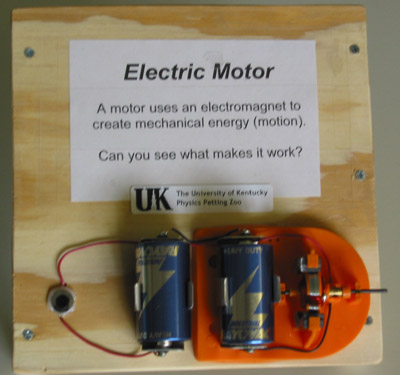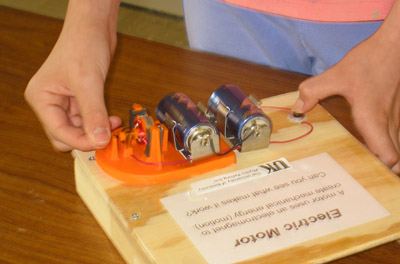
Instructions for:
Visible Electric Motor
The Visible Electric Motor consists of a plastic base, a battery and battery compartment, and a hand-wound electric motor, fully exposed. Here students can see what is going on inside a motor.
The motor consists of three electromagnets wound onto the same metal armature (the structure of the motor) using thin insulated copper wire. They are rather similar to the Electromagnet station. The electromagnets are placed facing radially outwards, and connected to three brass contacts, which rotate with the motion of the motor. The armature and windings are surrounded by two curved permanent magnets, placed oppositely of each other, which provide a north-south magnetic field orientation across the motor assembly. A set of two brass contacts, called brushes, provides the source of electricity to the motor, they are wired to both a set of batteries and pushbutton switch, which activates the motor only while depressed.
The contact where the brushes touch the shaft is in three pieces. At any orientation of the shaft, one of the electromagnets is connected in a different way from the other two, with the result that they feel different forces, which makes the shaft turn. But as the shaft turns, the electrical connections made by the brushes change, so that the motor continues to turn. With a fresh pair of 3V batteries, the motor spins at 250 rpm.
This motor was constructed at the University of Kentucky from a kit sold by Edmund Scientifics (
www.scientificsonline.com). The instruction manual for the kit is included. It contains descriptive diagrams of the science behind the electric motor, and the process of building one.Note:
The Visible Electric Motor uses a substantial amount of battery power. Replace the battery often as necessary, as the motor will cease to turn with a weakened battery source. It may also be necessary to apply a small amount of oil or other lubricant to the motor shaft mounts; locations where excess friction can cause the motor to stop, and wear the battery down quickly.

Questions/Items of Interest:
Q1) Can you point out the three electromagnets on the motor armature? Where are the permanent magnets?
Copyright 2004 Straley/Pinney - The University of Kentucky Physics Petting Zoo